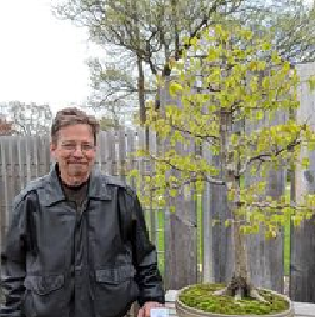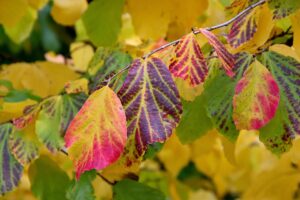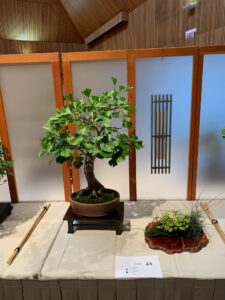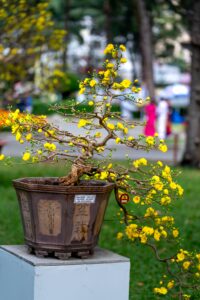Phil with his American Hornbeam collected in Tennessee
Interview with Phil Malhiot
Phil is a “Jack of all trades” and contrary to the old saying, “He is master of all”. Phil is proficient in the arts, creates beautiful stained glass and oils, he loves working with clay and has won top awards for his bonsai.
As he shares his thoughts, I found him to be honest, a total free spirit and completely devoted to whatever art form he is doing. Ask him a question and he is ready to answer with the knowledge only years of experience can convey.
Q: What did you think when you saw your first bonsai tree?
A: This is funny. I was in highschool and at a friends house. I opened their refrigerator and there was this tree in there. I asked “Dave what’s with the tree?” and he said “It’s a bonsai”
Q: What motivated you to get started into bonsai?
A: About 10 years later, in 1986, I saw an ad for Midwest Bonsai Society’s show at the Chicago Botanic Garden. Midwest was the structure that allowed me to come in contact with people in Bonsai.
Q: Who influenced/ helped you the most when you started into bonsai?
A: Kelly Atkins, my first workshop teacher, he was the best. He did a 6 week beginner course run by Midwest and he did a wonderful job. That put me over the top to get going in bonsai. Then I studied with Ivan Waters on Saturdays. I studied with Ivan for several years and then taught for him at his shop in Morton Grove for several more. I took loads of workshops. In the late 80s I took 2-4 workshops at every show to get different ideas with different varietes of trees.
Q: There are many outstanding bonsai artists in the world today. Which ones stand out in your opinion and why?
A: I am not a big follower of what is going on right now. I have been out of touch since the poisoning of my trees. That all changed my whole outlook. So for the last couple years I have just been recovering from the major trauma of losing over 1/2 my trees.
Q: What was your first tree and do you still have it?
A: I had it until it was sprayed with poison. It was an Amur Maple I had from the 1980s and now it’s gone.
Q: What is your most prized tree?
A: I have several, the trees I have had the longest. Because I lost so many there is not that many left that I collected in the 80s and early 90s. The Amur, the Larch, the collected Juniper, they are all my bigger trees, the older trees that I have left. I am now focusing on smaller ones.
Q: Like children we do not want to admit a favorite but among your collection, do you have a favorite?
A: Every year as the trees change it varies. It’s just that I have had them so long and they mean a lot. It’s like your kids, you get attached. I like them all. If I liked just one then I would get out of bonsai.
Q: You have both outdoor and tropicals. Do you prefer one type over the other and why?
A: Outdoor trees. I have tropicals just to keep a green thumb in winter, I have just 8-9.
Q: When you first started into bonsai, what did you enjoy the most about the art and has that changed over the years?
A: I have always enjoyed the initial creating of the tree more than anything in bonsai. I love taking an unfinished piece and making it into a bonsai. Shaping a tree has never changed. Most of my trees are refined so it is challenging and hard to keep up the enthuasim. That’s why I love teaching.
Q: What was the hardest thing you had to learn or master in doing bonsai?
A: None of it was all that tough. Wiring just took a little time but once I saw someone do something it never was that hard to do. I don’t do a lot of wiring any more, I like the tree rough and ragged so I am lucky that I don’t have to do that much any more.
Q: How did you feel the very first time you had to cut off a major branch?
A: Didn’t bother me at all. (laughs)
Q: A couple years ago you lost almost 3/4 of your trees. How did you recover from that?
A: I dont know that I have. Truth be told it just took time, like everything in life it just takes time. It happened, it’s over.
Q: When you first look at a raw tree, do you immediately know what you will be doing with it or does your vision develop over time?
A: At first I pretty much see several ways to style the tree but I look at the tree’s characteristics and it lets me know and see what it wants to be. If it wants to be an upright I style it that way. if it wants to be a cascade I always head in that direction tho because you don’t see that many cascades. Everyone should have a formal upright in their collection.
Q: What are your favorite genus of trees to work on?
A: I like collected trees from the midwest, they are probably my favorite. I like the Larch. I really like maples, hornbeams, sweet gum. Diciduous for their fall colors and evergreens for their green in winter. Junipers, Birch, you don’t see a lot of Birch.
Q: You seem to like all forms of Bonsai. One in particular comes to mind, your floating bonsai tree. How did you come up with that idea?
A: That was just a fluke, I said I am going to hang this thing and it was just fun.
Q: Like others in bonsai you judge and teach the art. How long have you been doing this?
A: I have been judging for about 12 years. I have been teaching since the mid 90s. Teaching bonsai helped me learn bonsai more than anything I did. I still teach now and have been invited to judge Midwest’s show this year.
Q: You are now creating pots for your bonsai use and others looking for an extremely unique bonsai pot. How do you come up with the ideas for your pots?
A: It’s the same thing like I paint, abstract. I was a carpenter for 40 years and had to measure, 6 inches was 6 inches, I had to follow the rules. So I like to break the rules, not be too rigid and completely abstract. It’s a learning experience. Many work traditionally, I like to have fun and if something works, great. I really like working with clay.
Q: Do you think you have mastered everything there is to know in bonsai or are there areas you still want to explore?
A: There is never an end to what one can learn. Bonsai is an endless road. Mostly because you change species and you change with the species. I showed a tree on a stand I made. I won an award of merit and the judge said the tree was spectactular but he didnt like the stand. It was to abstract and modern. I am always trying something to bend and stretch it a little bit so maybe we can find something new. I try to be organic.
Q: Has bonsai influenced the way you approach/ live your life?
A: I have always been an overdoer and worked too much. Bonsai was good for unwinding and slowing down the speed. Bonsai was good for me. Now its different, now I live bonsai. There is something to do everyday, i think about bonsai everyday. Now it isn’t a chore, it is a way of life.
Q: Any tips or advice you can give to a seasoned bonsai person or someone just starting out?
A: Stay the course. stay involved with people who are active in bonsai. That is where the inspiration to continue lies, in that connection with others and seeing other trees. Stay involved with active bonsai people and groups. Really important.
Q: What essential tools would you recommend to a newby just starting into bonsai?
A: Large concave cutters, spring scissors, bonsai wire cutters, and bonsai wire pliers. Those four have been with me since the 80s.
Q: In conclusion give me 3 words that describe how you feel about the art of bonsai or how it makes you feel?
A: Peaceful, Excited, Calm. Bonsai takes me on an extreme journey. Sometimes it’s exciting, sometimed it’s dull as beans but overall it’s a great ride, like life.
by Charlotte Field
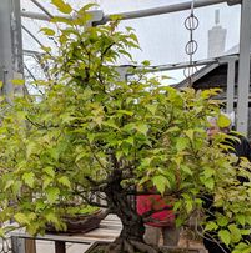
Phil’s beloved Amur Maple collected near Holland, Mi in 1986

